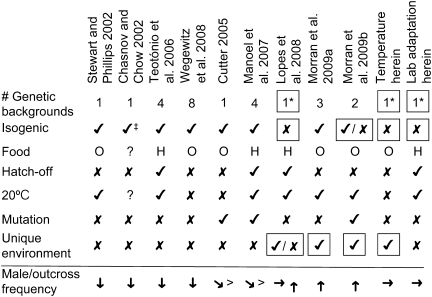Figure 5.
Summary of male maintenance experiments in Caenorhabditis elegans. Males/outcrossing can be maintained (horizontal arrow) or increase (up arrow) in frequency in experiments initiated with a heterogeneous populations or when isogenic lines are exposed to unique selective laboratory environments. When mutation rates are artificially increased, populations can have more males (>) than nonmutated controls; however, males are still lost from populations over time (diagonal down arrow). Males are otherwise lost (down arrow) from isogenic populations regardless of bacterial food type (Escherichia coli OP50 or HT115), maintenance regime (i.e., hatch-off), and temperature. Factors uniquely observed in concert with maintenance or increased male/outcrossing frequency are highlighted with boxes. Relative to factors listed at left, ✓, applicable; χ, not applicable; *, Starting strain derived by crossing up to 16 unique isogenic lines; ‡, Included wild-type and him-5 alleles in the N2 background; ?, unspecified.

